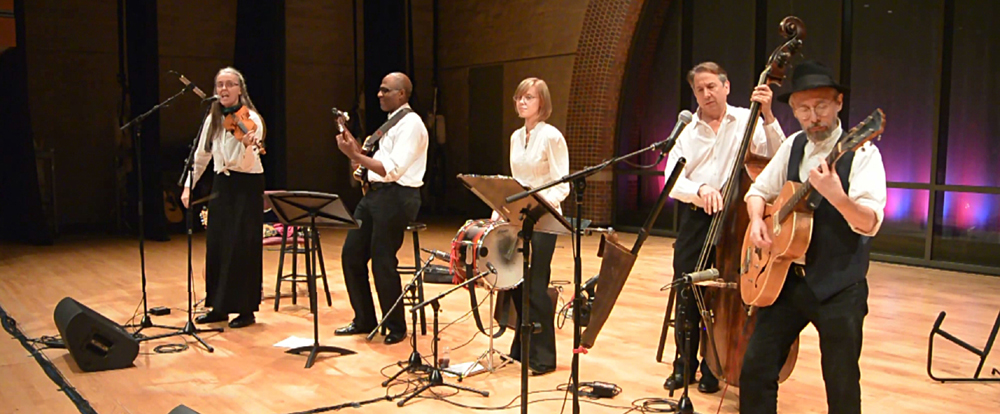JUTTA & THE HI-DUKES
Euro Roots World Music
BAND BIOS
A brief band history
The roots of Jutta & the Hi-Dukes (tm) are grounded in a number of different bands that were founded and led by Terran Doehrer; the most important of these was his first group, the Balkan Rhythm Band (tm), which he began in 1980.
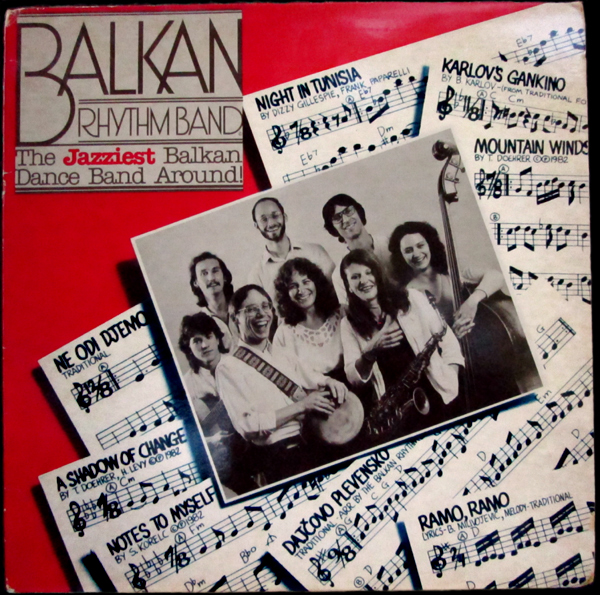
The BRB was one of the first World Music groups on the Chicago music scene, combining American jazz improvisation concepts with the songs, rhythms, and scales of Balkan music as well as taking American standards like the Dizzy Gillespie composition, “A Night In Tunisia,” and reshaping it by using a Balkan rhythm in 7/8 time.
In 1983, the Flying Fish record label released the BRB’s LP, “The Jazziest Balkan Dance Band Around,” which won the National Association of Independent Record Distributors’ (N.A.I.R.D.) award-for the “Best Ethnic Release” for that year. On the strength of that album, the BRB was invited in 1983 to perform at the prestigious Winnipeg Folk Festival in Canada, the largest festival of its type at the time as well as today.
Terran’s desire for a career in music got a huge boost in 1981 when he encountered one of his favorite musicians, Esma Redzhepova, at a local Serbian restaurant in Chicago when she and her band, the Ensembl Teodosievski, toured America for the first time.
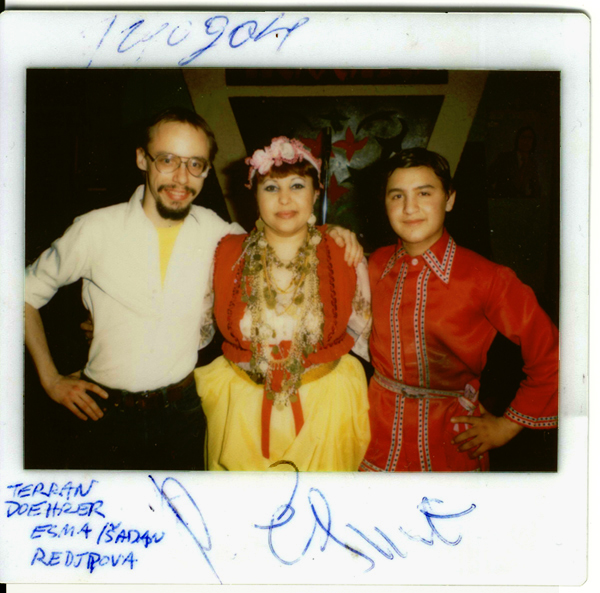
It was an amazing, fortuitous chance encounter because no one, including Terran, knew that Esma, probably the most famous Gypsy singer of all time from Macedonia, was in town. Terran had simply stopped in to have a late dinner after he and the BRB had played at Holsteins, a popular Lincoln Avenue music club. Ironically enough, some of the music the BRB performed that night included tunes that Terran had transcribed from LPs recorded by Esma and Stevo.
“I thought I was hallucinating,” Terran relates, “because here was this incredibly famous band sitting in Stari Beograd, a tiny, local bar without a single person for an audience. As soon as the musicians had played their first bar of music for us, I realized that, no, this was indeed, Esma and the Ensembl Teodosievski.” Terran and his musical colleague, Howard Levy (the first musician brought into the BRB by Terran), pulled out their instruments and stopped the group after their first piece to play back to Esma her own music. To say that Esma was astounded is a very big understatement.
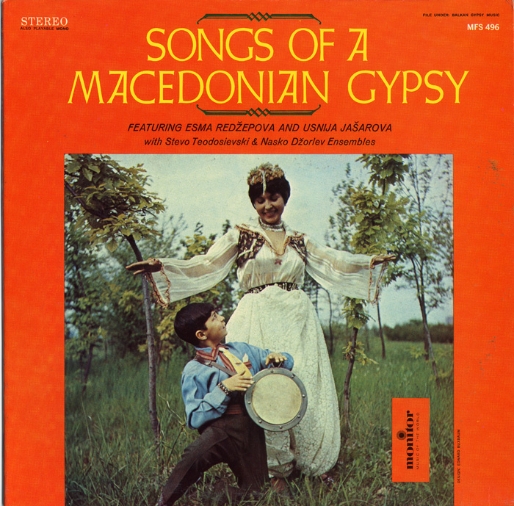
Terran got to know Esma and her band by escorting them around Chicago during their month in town. Esma and Stevo Teodosievski came to a number of the BRB’s rehearsals and taught them some tunes, explaining the rhythms and scales that are so special to Balkan music.
The audience numbers grew due to Terran’s efforts to draw listeners to Stari Beograd and he performed a couple of tunes as a guest with the group each weekend. At the end of Esma’s Chicago stay, she invited the entire BRB to play a warmup set for her band to a standing room only audience. Esma told Terran that he must continue playing Balkan music and by the next time she would come to Chicago, she expected him to know a bunch more of her music. An admonition that Terran has amply lived up to.
Over the years the BRB evolved and morphed as the player mix changed. By 1988, when Terran and Jutta Distler met on New Year’s Eve at a Balkan dance workshop held in a chalet outside of Zurich, Switzerland, the BRB was way into a Rock-Jazz-Balkan fusion sound.
Terran and Jutta danced the night away together and soon joined forces both as musicians and as a wedded couple. In early 1990 Jutta officially joined the BRB and Terran’s other ground-breaking band, the Ensemble M’chaiya(tm), Chicagoland’s first revival Klezmer band.
In 1990, Sanna Longden, leader of an International Folk Dance group, asked Jutta and Terran to play for a dance party because she knew the couple loved to play traditional Balkan dance music. However, the folk dancers wanted a folkloric sound instead of the rather loud, modern, electric sound the BRB had at the time. “We were happy to accept the invitation,” said Terran, “but we felt we should use a different band name so as to avoid confusing our rock fans by playing traditional music acoustically.”
“We never dreamed that we would ever use the name again after that party and as we thought of a temporary name we were thinking as a rock band. We liked bands with names like ‘Joe and the Jets’ and ‘Bill Halley and the Comets,’ so we began to toy around within that frame. As you can easily see, we named our band after Jutta. The other part of our name is a playful mis-spelling of ‘hajduk,’ a word that means ‘Freedom Fighter’ in the Balkans. Musicians who play rock and roll tend to see themselves as rebels and we were no different. In our ears ‘Jutta & the Hi-Dukes’ had a ring of royal rock rebellion and so at the folk dance party that night, we were officially a new band. Little did we know that years later this would still be our band’s name and that very soon we would no longer play as the Balkan Rhythm Band.”
Right on the heels of that party, a local school called the newly-named Hi-Dukes saying that they needed a band that could play traditional ethnic music for an International Day assembly program. The Hi-Dukes had never done this type of performance and asked the school for help to shape the program. Terran relates that, “They asked if we could teach the students some dances and songs as well as to get them drumming along with us. Happily, we could do all of that because Jutta and I are both dancers and musicians.”
That performance sparked the realization that the broad expanse of traditional music the Hi-Dukes played was a great way to introduce the world to students. So the band began to go to schools and libraries doing their new program, “Meet Your Neighbor’s Folk Music(tm),” which they have now presented to over 100,000 students across America and in Europe.
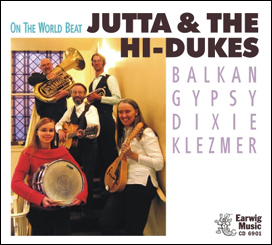
“It seems that I have a knack for getting connected to record labels that have unusual creature names,” Terran mused. “First it was Flying Fish Records and now it is the Earwig Music Company. Earwig released our CD (“ On The World Beat” CD6901) in October 2011 as its first foray into the World Music genre. The title is a play on the journalistic term ‘news beat’ and we are reporting back what we hear from the world, everything from hot Balkan / Gypsy songs to bubbling American Klezmer and Dixieland tunes as well as an original waltz melody that Jutta wrote in a Scandinavian style.”
On the CD the two are joined by their daughter, Zoï, who plays drum set, tupan (a double-headed Balkan drum played with two different weight sticks which consequently creates a high and a low sound), and sings. Three other musicians were invited to record with the band, long-time Hi-Dukes accordionist, Velizar Shumanov, the tuba-playing Steven Hart, and multi-instrumentalist Peter Bartels, who contributes cornet, flugelhorn and saxophone parts to the CD.
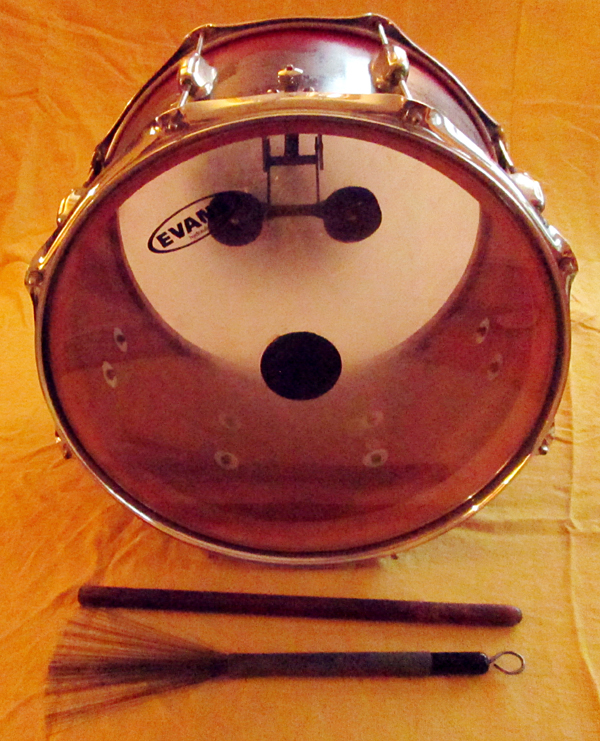
Terran’s sense of innovation goes beyond fusing musical ideas. He introduced a number of innovations to tupan playing, the most important being the replacement of the tupan’s thin stick with a drum kit player’s “wire brush,” a collection of thin metal wires held together in a handle that can be slid up or down the wires to make a tight stick-like bundle or a loose array of wires. When played with the wires loose, the brush creates a sound similar to that produced by the “snares” on the lower head of a Snare drum. When the wires are bunched together, it sounds much like a regular drum stick.
The heavy, beater stick also received Terran’s attention. Instead of the traditional club (in this case, a heavy stick with a rounded, up-turned head to add weight), he reasoned that by taking a regular drum kit player’s stick, cutting off the small tip to make both ends the same shape, he would now have two ends of the beater stick to hit the skin with and thus be able to play a type of drum roll that is very difficult to achieve with the asymmetrically-balanced traditional club.
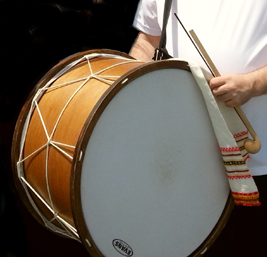
“Back in 1980,” Terran points out, “I did not have access to a traditional tupan, which is essentially a large drum shell with two goat or calf skins, one thick to be played with the club, the other thin to be played with a thin Willow switch. So I went into a drum shop and bought a large floor tom, took off the legs, turned it on its side, and using the drum’s modern technology of separately tunable plastic heads, I was able to actually tune the two heads to each other, producing a much more controllable, musical sound than that produced by a traditional tupan.” Unbeknownst to Terran, musicians in the Balkans were doing the same sort of adaptation around the same time.
Along the way, or rather, quite off the way, up in Wabeno, WI, Terran was gifted a deep shelled marching snare by some close friends. “The great thing about this drum is that it is small enough to carry on an airplane and put in the overhead luggage compartments,” said Terran. “On the other hand, being a much smaller size than most tupans, the snare lacked a certain amount of audible low frequencies. But then we went to hear a Sicilian folkloric group who only used tambourines for their percussion. I was totally confused because I kept hearing this huge, kick drum sound without a single big drum around. Finally I realized that the player was manipulating the microphone, taking advantage of the fact that low frequencies are emphasized the closer one gets to a microphone. I immediately started using a microphone designed for a kick drum whenever I could, and working with the sound board’s EQ settings to get this small drum to sound bigger.”
Ever the experimentalist, Terran then discovered that by purchasing a special type of drum skin that is composed of two layers of clear plastic filled with oil, he could even further accentuate the color differences between the two sides of the tupan because the oil-filled skin minimizes high frequencies.

So now Zoï plays what Terran has dubbed the “Tenor Tupan” which incorporates all of his innovations. By mounting a small cymbal on the top of the drum, one essentially has a drum kit (snare, kick, cymbal) that one can walk around with while playing it. Which Terran and Zoï do when they march in parades.
Jutta, who plays lots of strings (violin, mandolin, mandola, Greek baglama, and guitar), grew up in a musically-oriented family back in Arhus, Denmark. Her father played violin and was facinated by the Hungarian and Rumanian Gypsy music as well as Spanish Flamenco and even Egyptian music.
Jutta picked up on her father’s love of these (to Danish ears) exotic sounds, and convinced her high school violin teacher to teach her some Serbian melodies. While studying in Switzerland, she and a friend would get together to play Balkan music from music charts they acquired from various sources. This involvement led Jutta to learn to speak Serbian and to visit the country a number of times.
The violin bow did not drop far from the violinist. Both of Jutta’s brothers play music and one has a band in Sweden that plays Balkan music in addition to traditional Swedish tunes.
Terran plays kaval (a Bulgarian-style, end-blown, wooden flute), guitar, bass guitar, ocarina, darabuka (an hour-glass shaped hand drum popular in the Balkans), and tupan. His first instrument was a plastic turtle bowl that, after the turtles had died, he would turn over and beat on while taking a bath.
Terran also had a musical childhood as his father, a Big Band afficianado, would plunk away as he composed songs and Terran’s mother loved to play the piano and guitar. Terran recalls that she was a close friend of “Blind” Arvella Gray, a Blues singer of Maxwell Street renown, who played slide on a steel resonator guitar because a number of fingers on his left hand were shot off by a jealous lover.
Even as a very young child, Terran’s taste in music included non-American music. Ravel’s “Bolero” was a tune which he would sit and listen to multiple times in a row, fascinated by how the simple melody kept developing and growing with each repetition.
While in the seventh grade, Tim Black, a school chum, convinced him to join the original Chicago Children’s Choir. Singing as a First Soprano, Terran got his first taste of touring with the choir, performing at Expo’67. He and the choir also sang under Seiji Ozawa at Chicago’s Orchestra Hall.
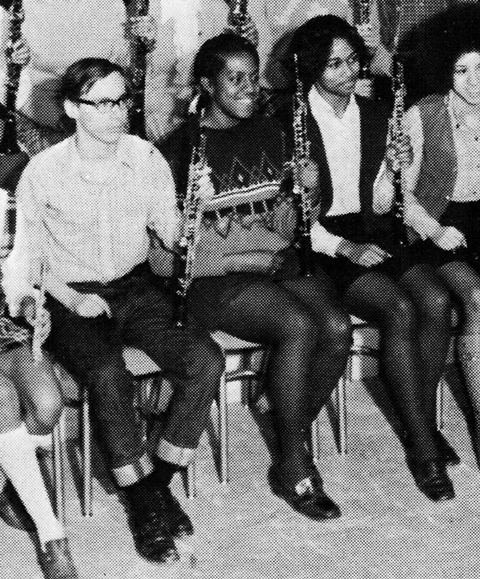
In high school, world-famous jazz-pianist Willie Pickens was Terran’s band teacher. Years after graduating, while taking a playing break at a private party, Terran saw Mr Pickens outside of the event’s room and greeted the rather surprised musician. When told that the BRB was his band, Mr Pickens replied, “I knew you would do well in music. That’s why I gave you the oboe to play.” Terran remained first chair oboe for the three years he was in the high school band.
Zoï Doehrer, the Hi-Dukes’ percussionist, guitarist, and singer, grew up on stage, literally. When the Hi-Dukes appeared at the Bliss Fest in northern Michigan, at the age of one, she refused to be separated from the band while they did their performances and someone came up with a brilliant solution — a baby backpack. Thus, Zoï got to see and hear and participate from the best seat in the house. As she got older, she would sit on the side of the stage with her toys and drawing books until she decided she would play with the band on darabuka.
By the time she was six, Zoï was professionally leading the dance lines at parties and concerts that the Hi-Dukes played at. Later on, she briefly studied clogging and today her love of dance continues in the form of Flamenco, the firey dance style of the Spanish Gypsies.
For a number of years Zoï also played cornet. She was inspired to pick it up after attending an un-amplified concert by the Serbian flugelhorn master, Boban Markovic, in 2004. She studied with Bulgarian trumpet master Marin Hristov and has got the incredible opportunity to jam with Boban Markovic’s brass band in 2008.
Zoï and Terran created a special group, Two For Tea (tm), as a vehicle to pursue their common interest in Dixieland and Big Band music and to focus on her singing and playing.
However, Zoï decided to put down the horn and focus exclusively on percussion. She got her first taste of playing drum kit up in Wabeno, WI (yes, the same place her Tenor Tupan hails from) and that experience convinced her that her real calling in the music world was drumming.
Somewhere along the line though, without missing a beat she began writing songs and playing guitar. In 2022 Zoï and James Kuhn created the Dueling Owls (tm), a music group to present the original songs the two composed together. Barely out of the nest, they played in Denmark and Sweden as well as in Wisconsin, Michigan, Illinois, and New York State!
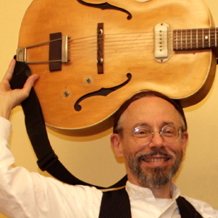
Terran Doehrer
Hi-Dukes leader and co-founder, kavalist, percussionist, guitarist, and vocalist.
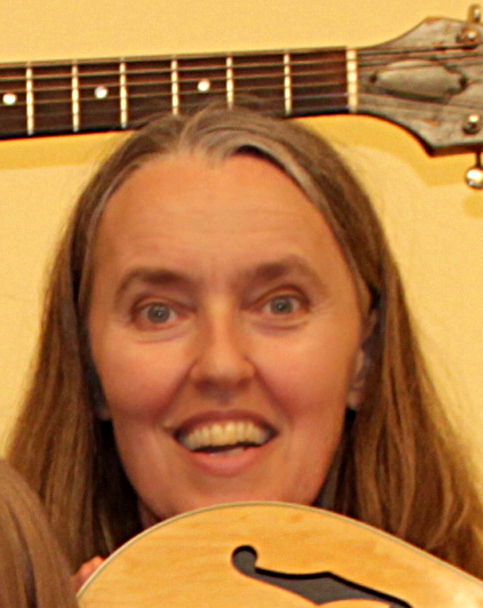
Jutta Distler
Hi-Dukes co-founder and mandolinist, violinist, guitarist, and vocalist.

Zoï Doehrer
Percussionist, guitarist, vocalist, and core member of the band since 2002.

Velizar Shumanov
Accordionist and tupanist with the Hi-Dukes since 1997.
Velizar was born in Bulgaria and escaped from there with his wife to Italy, finally ending up in Chicago. Shortly thereafter, a mutual acquaintance introduced Velizar to the Hi-Dukes. Missing the music of his native country, Velizar wanted to play it and was astounded to find the Hi-Dukes, a group of non-Bulgarians, playing traditional Bulgarian music. Both he and the Hi-Dukes took a liking to each other and a fast musical / personal relation was forged. Later on, Velizar also formed his own band, Orkestra Izgrev, with some fellow musicians from Bulgaria.
Hi-Dukes of Note
With roots that harken back to the nine-piece Balkan Rhythm Band, the Hi-Dukes love to bring on board extra musicians whenever feasible, most drawn from various ethnic communities. Notable players include: Velizar Shumanov (Bulgarian, accordion, tupan - leader of Orkestra Izgrev), George Petrov (Bulgarian, tupan, accordion - who recorded and performed on drum set with Yuri Yunakov), Konstantin Marinov (Bulgarian, tupan), Blagoj Lamnjov (Macedonian, clarinet, tupan), Jim Lemonides (Greek, bouzouki), Mark Gavoor (Armenian, oud), Al Alvarez (percussion), Donovan Mixon (Jazz guitarist extraordinaire), Steven Hart (tuba, acoustic bass), Bryan Tipps (trombone), Eli Wilson (tenor saxophone), Mitch Straeffer (acoustic bass), and Marc Edelstein (a founding member of the Special Consensus Bluegrass Band, and acoustic bassist for the award-winning Broadway play, “Million Dollar Quartet”).
Folks we have had as guests
James Stoynoff, Lupcho Kacovski, Patric Marks, Steve Roberts, Petar Teodosijev, Theodosii Spassov.
Folks who had us as guests
Bryan Bowers, Daniel Wallenberg’s Music Institute of Chicago Chorale, Gary Geiger’s Evanston Children’s Choir, Celebration of Slavica Petrovic’s Ogledalo – Serbian Mirror News’ Anniversary.
Playwrights we have worked for
Joanne Koch, Christa MacBeth.
Noteable performances we hosted
From Darkness To Light — Benefit to raise money for Turkish earthquake relief.
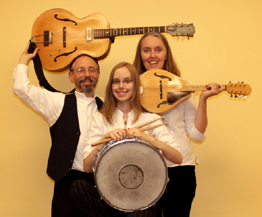
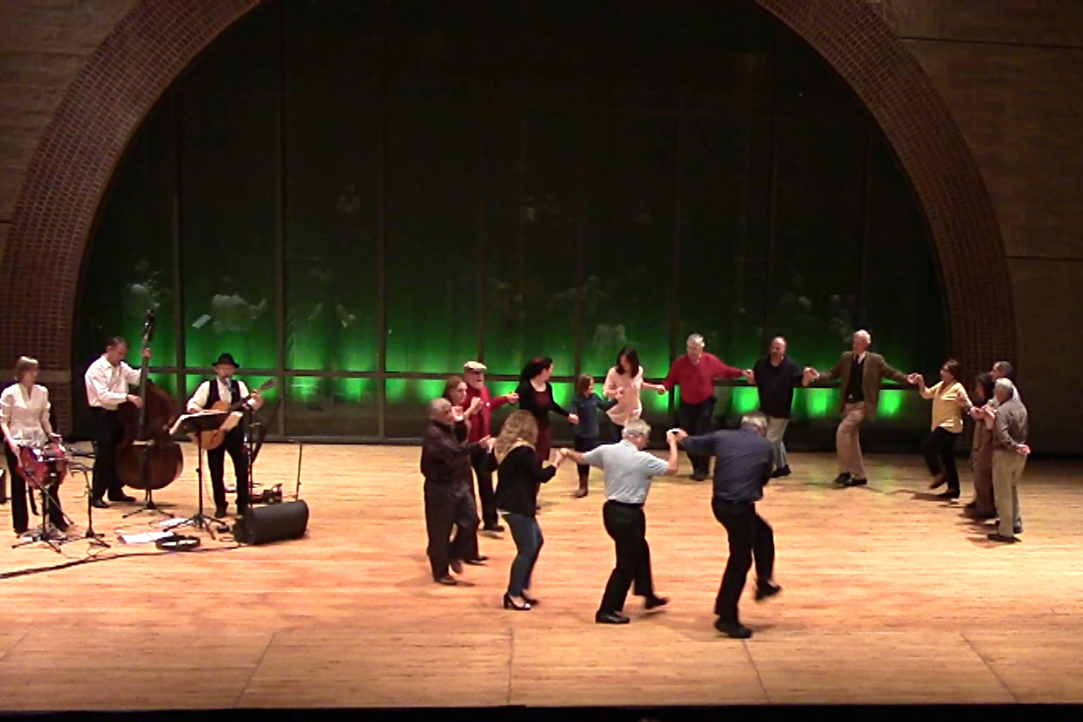
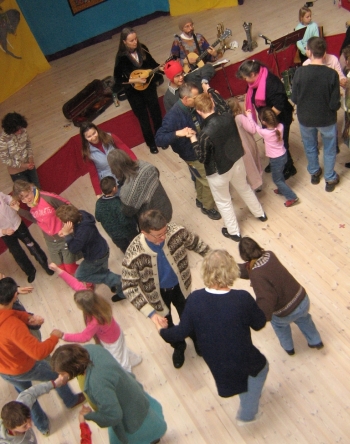
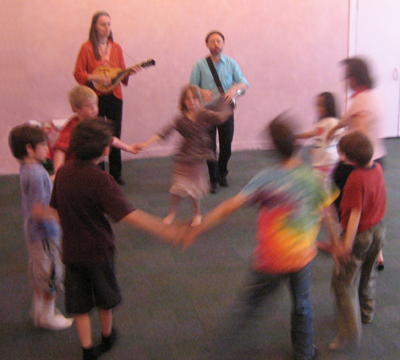
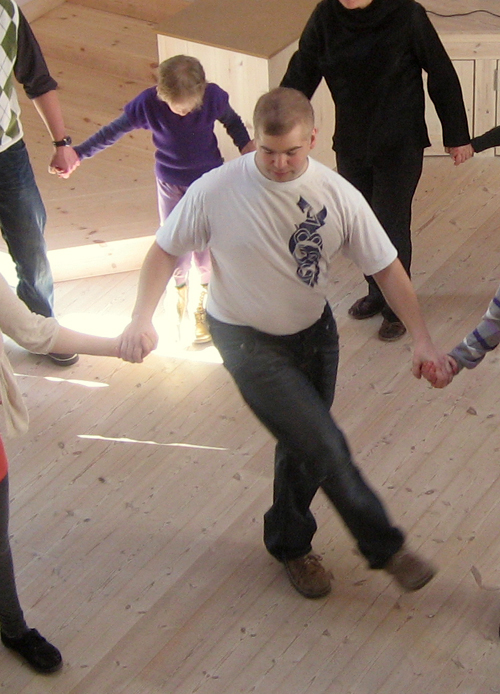
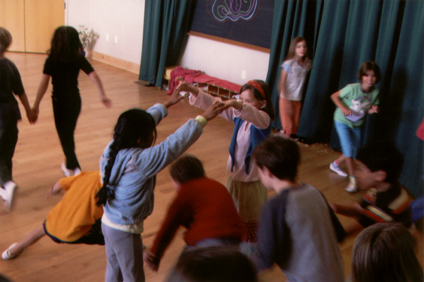
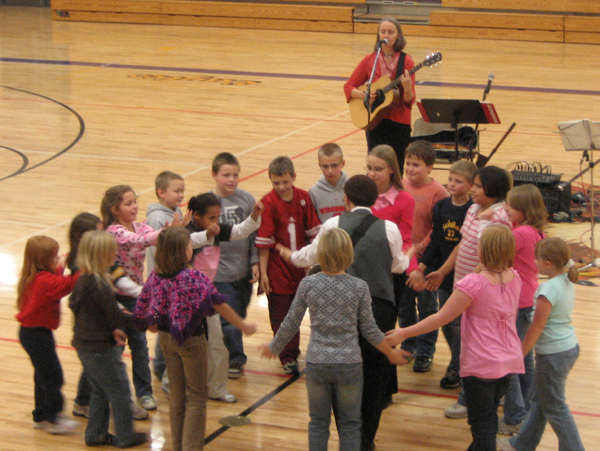
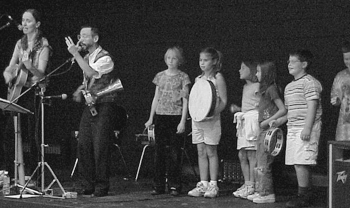
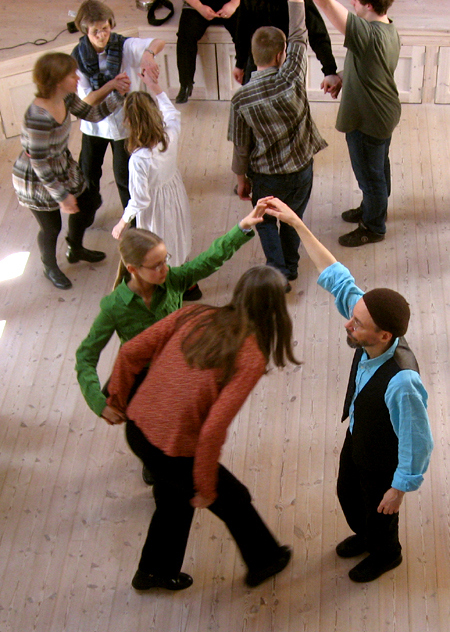
Flexible and affordable
We are happy to customize our programs to fit your interests and to adjust the band’s size to your budget and needs.
